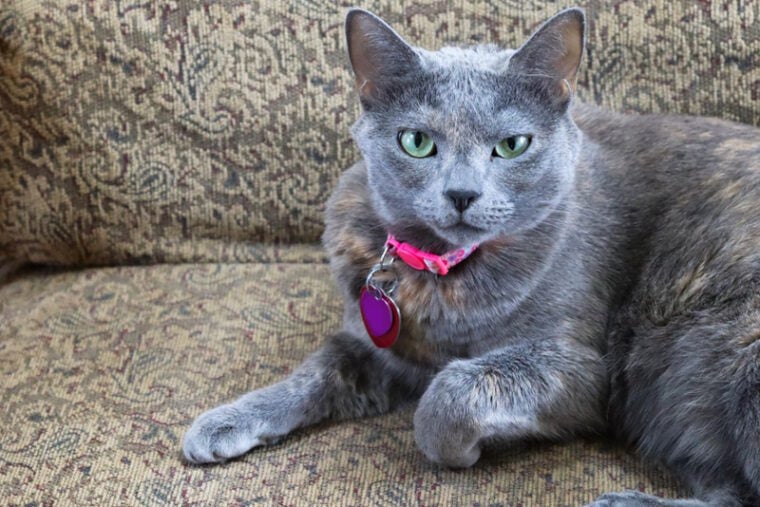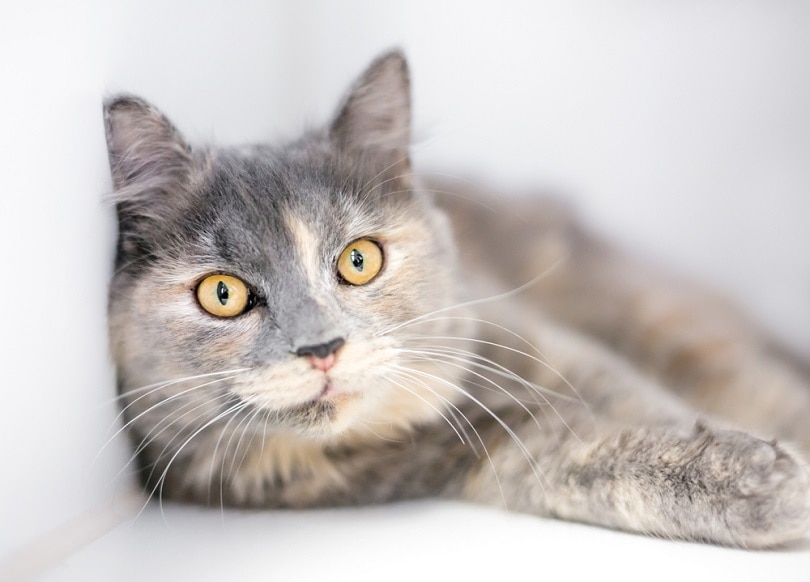
Click to Skip Ahead
Dilute Tortoiseshell cats, also known as dilute or muted Torties, are a lighter version of regular tortoiseshell felines. Instead of having lively shades of black and ginger red, their pigmentation is dilute. They bear patches of blue-gray and cream, although they have similar coat patterns as regular Torties. Dilute Tortoiseshell coloring is not specific to any one cat breed rather is a generic color variation that can occur in almost every cat breed.
Muted Torties have a softer and more subdued appearance because of a rare mutation of the MLPH or the melanophilin gene. While they have less vibrant pigmentation, these cats make excellent family pets because of their lively personalities.
Want to learn more about dilute Tortoiseshell cats?
Read on for detailed information about their origin and history. We will discuss their breed profiles, personalities, care needs, and more.
Dilute Tortoiseshell Characteristics
A Dilute Tortoiseshell’s characteristics will be determined by the cat’s breed rather than its genetic coloring.

The Earliest Records of Dilute Tortoiseshell Cats in History
Dilute Tortoiseshell cats have been around since ancient times. They are not a specific feline breed, but get their name from their distinctive coat pattern and hues. While regular Torties have black and ginger-red patches, muted Torties have a blue-gray and cream coat pattern.
The exact origin of the dilute tortoiseshell markings is murky. While the unique coat pattern and hues have appeared since time immemorial, it was not until the 21st century that their cause was deciphered. Leonard Doncaster, a geneticist, proved that Torties are caused by genetic mutations.
Different cat breeds can exhibit muted tortoiseshell markings, including Persians, Maine Coons, American Shorthair, and Cornish Rex, among others. Ancient folk, especially people in South East Asia, believed these cats had a divine origin. They claimed Torties emerged from the blood of a goddess born of a lotus flower.

How Dilute Tortoiseshell Cats Gained Popularity
Dilute Torties were the subject of many old wives’ tales, so these felines were popular from the beginning, with many believing they brought good luck and fortune. In Japan, the cats were believed to protect homes from ghosts. The Americans alleged they brought wealth and prosperity and nicknamed them “money cats.”
Although rare, muted Tortoiseshell cats are and have always been popular. People find their markings and color desirable for their uniqueness and relative scarcity. Also, the auspicious legends about the felines bringing good luck have made them a top choice for people worldwide.

Formal Recognition of Dilute Tortoiseshell Cats
Dilute Tortoiseshell refers to a specific fur color and pattern. It is not a particular feline breed that can be classified and registered based on specific standards.
Still, bodies like the Cat Fanciers’ Association (CFA) recognizes dilute Torties from breeds like the American Shorthair, Turkish Van, and Lykoi, among other cat breeds.

Top Five Unique Facts About the Dilute Tortoiseshell Cat
Tortoiseshell cats are considered rare and dilute Torties are even rarer. The tortoiseshell gene almost exclusively manifests in female cats, making finding a male Dilute Tortie extremely challenging. While there is a chance of getting one male in every 3,000 Torties, there’s a probability that it will be born sterile or have potentially life-threatening health issues.
If you are lucky enough to have a dilute tortoiseshell cat, here are five unique facts about it.
1. How the Dilute Torties Occur
The genetic mutation that causes dilute Torties occurs through a recessive gene. Both cat parents must have a unique MLPH gene to produce a dilute tortoiseshell offspring.
The X chromosome carries a plethora of data, including instructions on how the coat of a kitty should appear. Females have two X chromosomes, allowing them to receive two different sets of instructions regarding coat color and pattern. Regular Torties occur when a female’s X chromosomes receive instructions for the coat to appear ginger red and for it to appear black.
The MLPH gene in cats dictates the vibrancy of their coat’s pigmentation. This gene sometimes mutates through a recessive gene carried by both cat parents to produce a dilute Tortie.
2. Coat & Appearance
The patterns and color of a cat’s coat are influenced by genetics. Regular Torties have the MLPH (melanophilin) gene that gives them patches of ginger red and black.
Sometimes, the MLPH gene mutates and dilutes the pigmentation of a cat. In muted Torties, the ginger red appears cream or yellowish, while the black coat hue appears bluish-gray.

3. Personality & Temperament
Dilute Torties have a distinct personality. Many cat parents swear these felines have a “tortitude” (attitude). They have strong personalities characterized by sassiness, feistiness, and potential for aggression.
But is there a relation between coat color and personality?
Studies to establish a link between a cat’s coat color and behavior are currently inconclusive. Numerous dilute Tortie owners also claim that their cats have calm and loving temperaments like other felines. You can increase the chances of your pet being well-mannered by ensuring proper socialization from a young age
4. Care Needs
Dilute Tortoiseshell cats are not prone to any specific health conditions. Like all other cats, they need a balanced diet that matches their nutritional needs. It is crucial to consider your cat’s life stage to determine its dietary requirements and the food proportions it needs.
Depending on your cat’s breed, ensure you groom it routinely to control shedding. Also, schedule regular vet visits and invest in pet insurance to manage your vet bills more easily.
5. Life Expectancy
The life expectancy of a dilute Tortie depends on numerous factors, including the quality of care it receives. Generally, these felines live for 10 to 15 years with proper care. Keeping your cat indoors, scheduling routine vet visits, and providing appropriate nutrition can increase the odds of it living to 17 years or older.

Does the Dilute Tortoiseshell Cat Make a Good Pet?
Dilute Torties make excellent pets owing to their unique appearance and personalities. While some are gentle and friendly, others are extra-confident with all manner of quirky habits.
The probability of adopting a cat with a “tortitude” should not deter you from adding this gorgeous feline to your household. After all, how you rare and treat your muted Tortie can have a significant bearing on its personality. Even if it turns out to be mischievous at times, that’s just part of the charm of owning this gorgeous cat!
Like most cats, dilute Torties are fiercely independent, curious, and playful. Their unpredictable attitude can spice up your life and make you grow a soft spot for your pet. When raised right, muted Torties make excellent lifelong companions.

Conclusion
Dilute Tortoiseshell cats have muted pigmentation caused by their genetics. They are not a specific feline breed but a unique pattern and color that can occur in numerous cat breeds, including purebreds and mixed breeds. These cats have a rare recessive gene that gives their fur a washed-out or dilute appearance.
So, should you introduce a dilute Tortoiseshell cat to your household?
See also: How Long Do Tortoiseshell Cats Live? Average Lifespan & Facts
Featured Image Credit; Jaynelle Summerville, Shutterstock





